Book Binding Ideas for Beginners to Expert: A complete guide
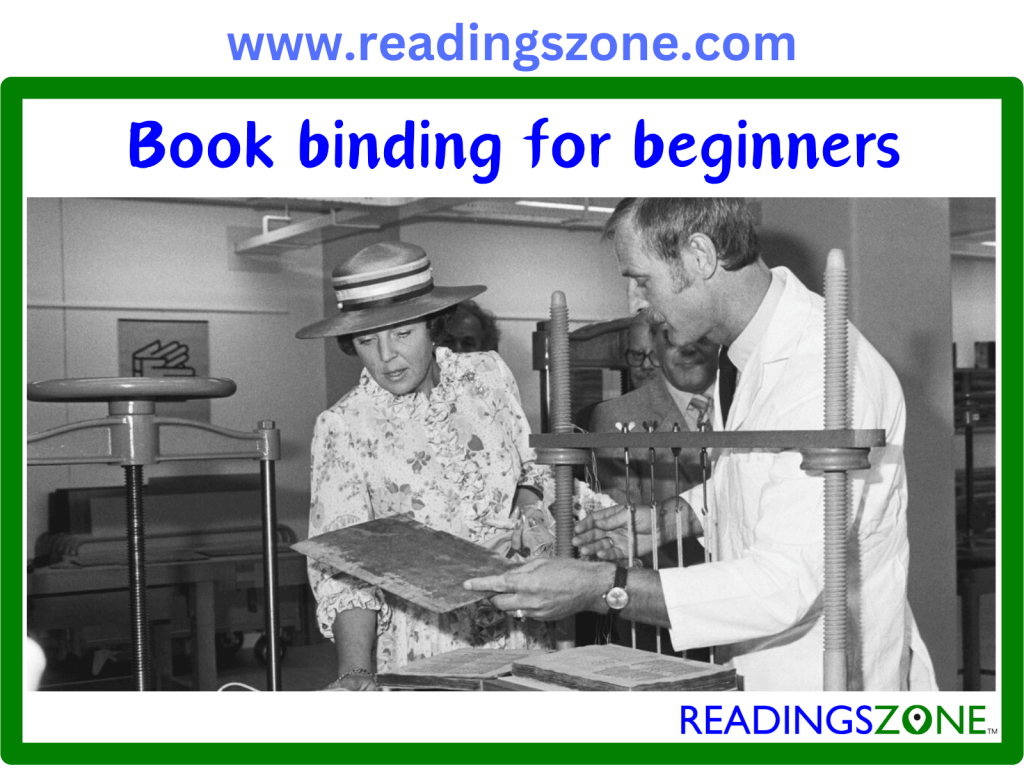
Bookbinding, an age-old craft, blends art with functionality. It’s a journey through history, where each fold and stitch tells a story of evolving techniques and personal expression. Whether for individual projects or as a stepping stone into a professional sphere, learning bookbinding for beginners opens up a world of creativity and practical skills. Bookbinding unlocks creative opportunities and practical skills. It enables you to explore your imagination and gain useful expertise. This skill can be valuable for both personal and professional pursuits.
Table of Contents
Toggle
Further explore the total care of books-how & effectively
The Basics of Book Binding
What is Bookbinding?
At its core, bookbinding is physically assembling a book from ordered paper sheets bound together and encased in a protective cover.
Types of Bookbinding
There are numerous styles, each with its charm. Traditional methods like Coptic or Japanese stitching have existed for centuries, while modern techniques adapt to contemporary needs and aesthetics.
Ⅰ.Coptic Stitch Binding:
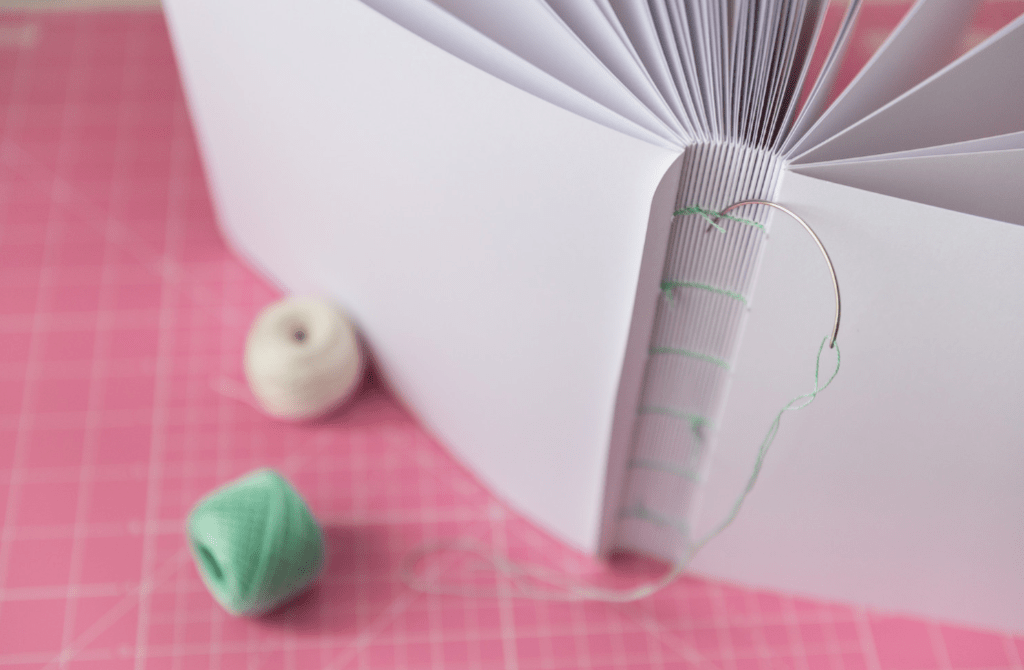
Description: Coptic binding is one of the oldest known bookbinding methods, dating back to the second century AD. Its exposed spine characterises it, allowing the book to lie flat when opened.
Technique: In Coptic binding, sections of folded pages (signatures) are sewn together using a distinctive looping stitch across the spine. This creates a beautiful, visible pattern.
Advantages: Coptic binding provides excellent flexibility and durability. It’s ideal for sketchbooks, journals, and handmade books with decorative covers.
Charm: The exposed spine and decorative stitching give Coptic-bound books a unique and rustic appearance.
Ⅱ. Japanese Stab Binding:
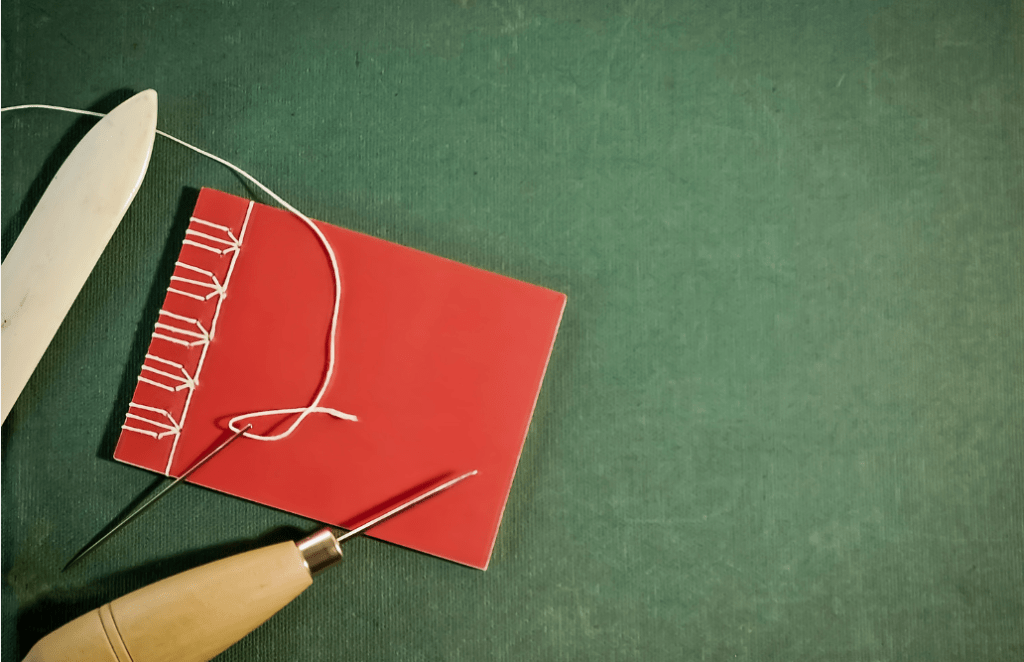
Description: This traditional Japanese binding technique is known for its simplicity and elegance. It’s often used for single-sheet books and notebooks.
Technique: Japanese stab binding involves punching holes along the spine edge of the pages and covers and then stitching them together using various patterns of stab stitches.
Advantages: It’s easy to learn and doesn’t require specialized tools. Japanese stab binding is perfect for small projects like photo albums and poetry books.
Charm: The visible stitching patterns on the spine make Japanese stab-bound books visually appealing.
Ⅲ. Saddle Stitch Binding:
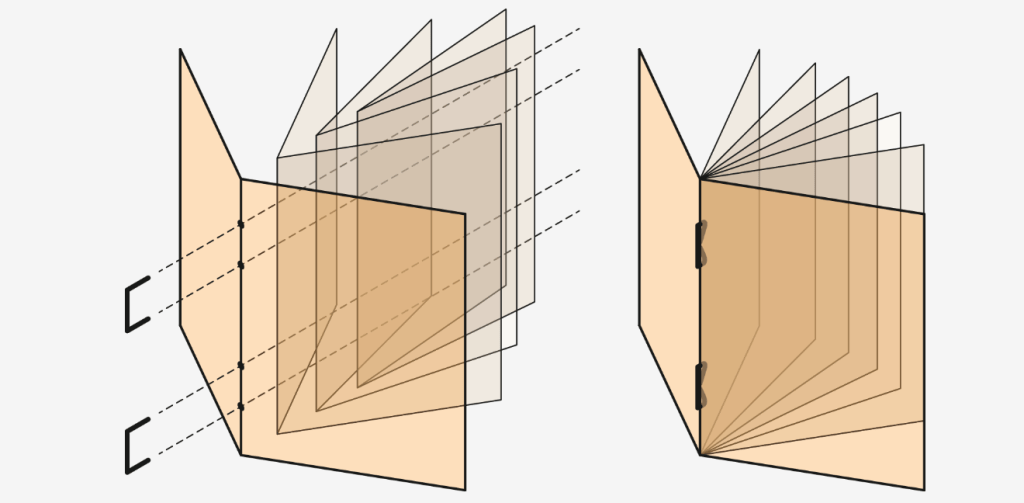
Description: Saddle stitching is a simple and common binding method suitable for pamphlets, brochures, and small booklets.
Technique: In this method, folded sheets are stacked on top of each other and then stapled or stitched through the fold (saddle) in the center. The result is a book that opens flat.
Advantages: It’s quick and cost-effective, making it suitable for mass-produced materials. Saddle stitch binding is often used for magazines and promotional materials.
Charm: While not as decorative as other methods, saddle stitch binding offers practicality and ease of production.
Ⅳ. Perfect Binding:
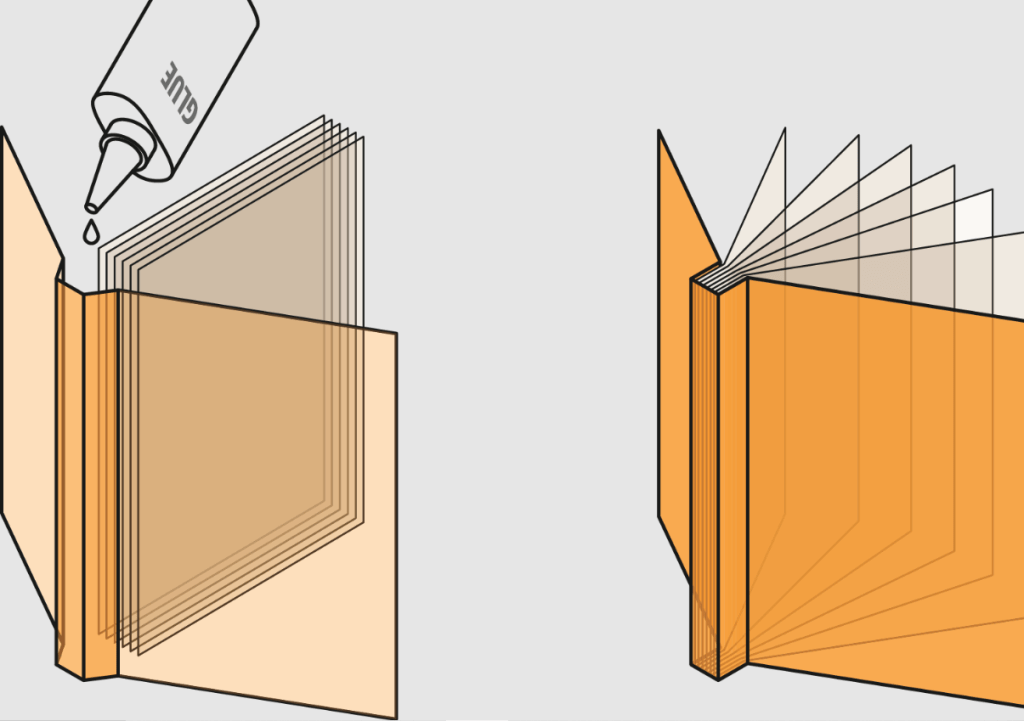
Description: Perfect binding is the technique commonly used for paperback books, including novels, catalogues, and manuals.
Technique: Individual pages are cut to size and glued together at the spine. A flexible paper or cardstock cover is then glued to the spine, concealing the adhesive.
Advantages: Perfect binding provides a clean and professional finish, allowing for the printing of titles and graphics on the spine. It’s cost-effective for large print runs.
Charm: The sleek appearance of perfect-bound books is ideal for modern publications and commercial printing.
Ⅴ. Wire-O Binding:
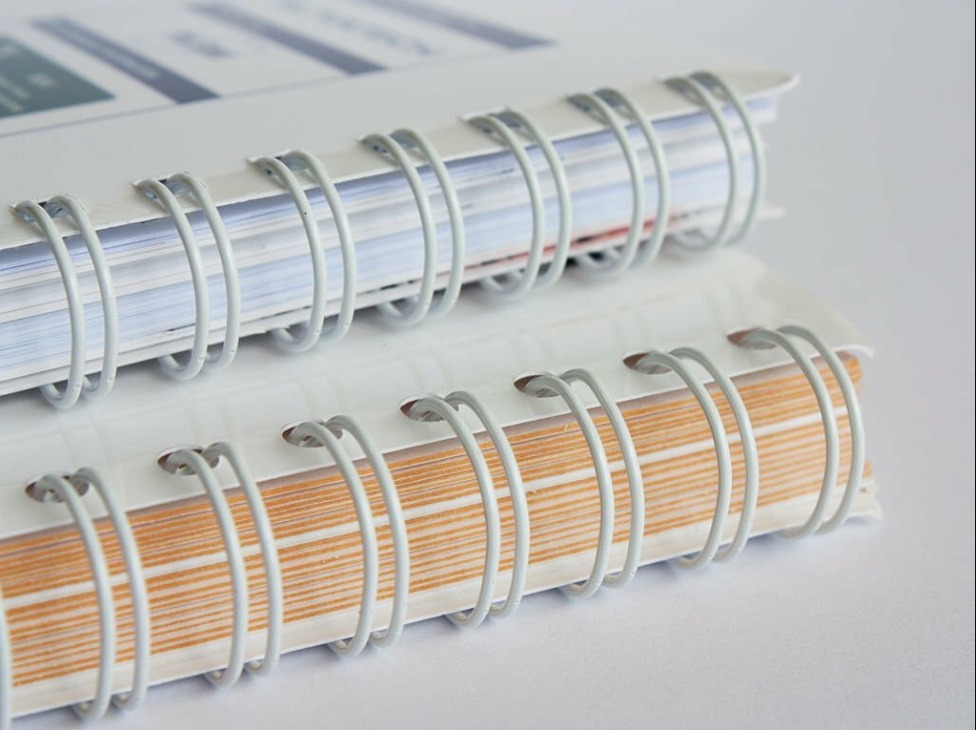
Description: Wire-O binding, also known as twin-loop or double-loop binding, is used for notebooks, calendars, and presentations.
Technique: Pages are punched with evenly spaced holes along the binding edge. A wire or metal coil is then threaded through the holes and crimped to hold the pages together.
Advantages: Wire-O binding allows the book to lay flat, and pages can be turned 360 degrees. It’s suitable for materials that need to be opened and closed frequently.
Charm: The wire binding offers a clean and professional look while ensuring durability.
All of these five are just a few of the many ways to bind a book. Each method is different in its ways, so it can be used for different kinds of projects and to fit different tastes in design. There are a lot of creative ways to bind books, whether you choose a traditional method like Coptic or a more modern one like perfect binding.
Great Book by Pauline Johnson’s “Creative Bookbinding”
Pauline Johnson’s Creative Bookbinding is a classic, all-in-one guide that is needed for learning the old and gratifying art of hand bookbinding. It is more than just a how-to book; it shows how constructing a hand-bound book is an act of artistic design and personal expression. This makes it a favorite book for beginners and a crucial reference for experienced crafters.
Read this book from– Google Books
Why You Need This Book
The book’s main strength is its precise, step-by-step method, which is backed up by more than 600 excellent pictures and illustrations. Johnson’s concept makes the reader think of bookbinding not simply as a way to keep things safe, but also as a way to make a unique, treasured piece of art.
For the Beginner: It starts with the basics and takes the reader from simple tasks like folders, notepads, and brochures to full-size, stitched books.
A Focus on Design: The guide goes beyond just the technical procedures and goes into great detail about book design, including proportions, choosing materials (cloth, leather, paper), and the book’s aesthetic parts.
The Art of Paper: A big part of it is making decorative papers, which are an important part of the visual art of good bindings. This gives you ideas for unique cover and endpaper treatments.
Important Areas Covered
The content is organized in a way that helps the reader learn skills step by step, making sure they know both the “how” and the “why.”
Basic Knowledge: A short history of printing and binding to give the craft some background.
Tools and Materials: A full list of the tools and materials you’ll need and where to get them.
Simple Constructions: How to bind simple folios and magazines, as well as basic sewing and gluing ideas.
Advanced Techniques: Complete instructions for making full-size stitched books with both cloth and leather bindings. These include methods like tooling, stamping, and embossing.
Preservation and Repair: This chapter is very useful since it explains how to keep and fix books that are damaged or can’t be replaced.
Binding materials for books
Paper (created for Bookbinding):
This is paper that is made and created, particularly for use in bookbinding projects. The paper you use should be of good quality since it will be the main part of your book. The type of paper you use can change how the end product looks, feels and lasts. Depending on what the book is meant to be used for, different kinds of paper can be used, like drawing paper, writing paper, or watercolor paper.
Adhesives:
These are the things that hold the different parts of the book together. Adhesives are often used in bookbinding to join the cover to the spine, keep loose pages in place, or tie parts of the book together. PVA (polyvinyl acetate) glue, glue sticks, and custom bookbinding glue are all common types of glue used for binding books. What kind of glue you use depends on the materials you’re using and how long you want the glue to last.
Threads:
The parts (also called signatures) of your book are sewn together with threads. When you sew like this, you might hear it called “bookbinding stitching.” The thread you choose can change how strong and nice the book’s binding looks. Linen thread, waxed thread, and nylon thread are all common types of bookbinding thread. You can also pick the thread’s color and thickness to fit the style of your book as a whole.
Covers:
Book covers are the pieces that protect the outside of the book. The covers protect the pages inside and add to the look of the book (aesthetically). The text says that different kinds of materials can be used to cover books, and each has a different look and amount of durability. Covers are often made of cardboard, leather, cloth, or fancy paper. The choice of cover material has a big effect on the style and sturdiness of the book as a whole.
Bookbinding supplies list
A bone folder for creasing, an awl for hole punching, sewing needles, and glue application brushes are indispensable. Now let’s know those in short.
a.Bone Folder:
A bone folder is a useful tool that can be made from bone, plastic, or other materials. It has a flat end that is a little curved and a round end. Bone folders are mostly used by bookbinders to smooth and fold paper and other materials. They can help remove wrinkles and air bubbles when applying glue and make paper folds that look clean and professional. When you’re binding books, you need bone folders to get neat and accurate results.
b.Awl:
The point of an awl is very sharp, and it is used to make holes in paper, wood, and other things. An awl is a tool used in bookbinding to make holes properly spaced along the spine of folded pages or sections. You can put the book together with these holes to make a strong binding. There are different sizes and forms of awls, and they are an important tool for many binding methods.
c.Sewing Needles:
The parts or signatures of a book are sewn together with sewing needles, which are usually big and strong ones. Bookbinding thread is wound through the holes made by the awl. Sewing needles are then used to pull the thread through the holes and make a strong, secure binding. Choose the right sewing needle for the job based on the type of binding and the thickness of the materials being bound.
d.Glue Application Brushes:
These are brushes that are made to apply glue in a controlled and accurate way. Bookbinders use glue application brushes to spread glue or adhesive equally on the spine, cover, or edges of pages, among other parts of the project. Using a brush makes sure that the glue is spread out evenly and easily, which helps make a neat binding that will last.
Most important notes for beginner bookbinding
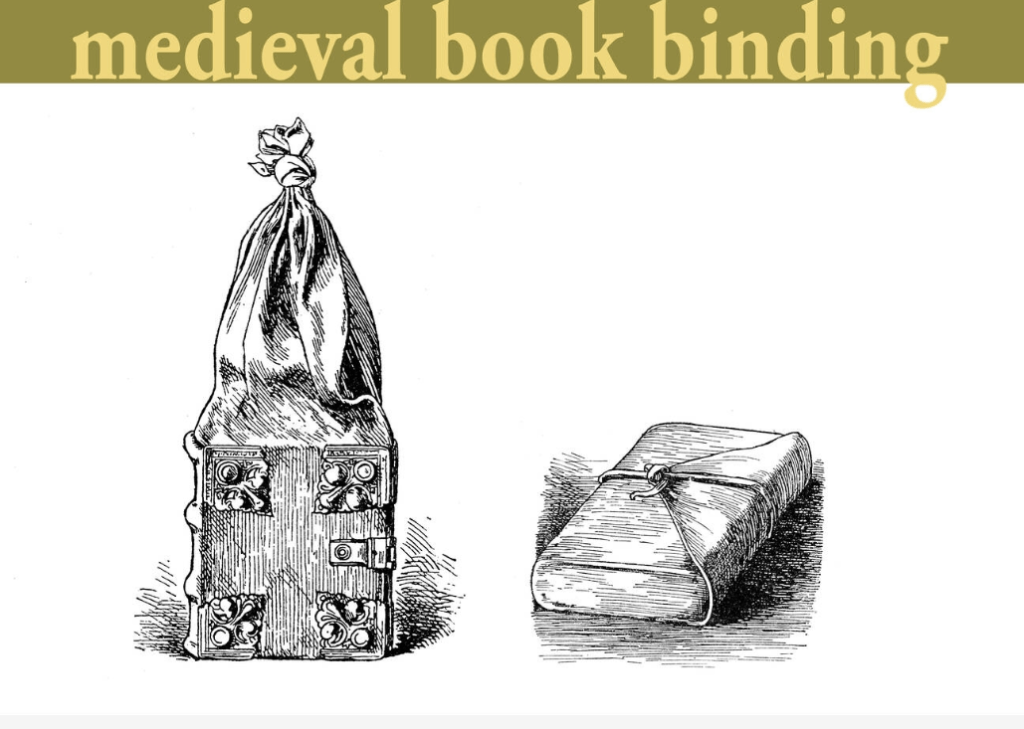
a.Cut and fold the paper into signatures
A “signature” in bookbinding is a group of pages that are wrapped together as a single unit. After being folded, these signatures are made or glued together to make the pages of the book. Cut the paper to the right size for your book pages and then fold it into these signs to get it ready to be bound.
b.Cutting Paper
The pieces of paper need to be measured out and cut to the exact size you want for the book. This size can change based on the book you’re making and its style. To make sure that all the pages are the same size and the book looks neat and professional, you need to be very precise.
c.Folding into Signatures
When you’re done cutting the paper to the right size, you fold each sheet or several sheets together to make a signature. It is very important to fold the paper evenly and properly so that the pages line up correctly when the book is bound. Signatures are usually folded in half, but they can be folded in different ways based on the method used to bind the book.
d.Precision is Key
The text stresses how important it is to be careful when working with paper in bookbinding. This level of accuracy makes sure that all the pages are the same size and that the folds are always the same. When pages are cut and folded correctly, the book is well-bound and the pages turn easily and look like they were made by a professional.
Adding a Personal Touch
Adding a personal touch to your bookbinding projects can make them truly special and meaningful. Here are 4 tips to consider:
a. Customization:
First, think about what makes your book special. Is it your notebook, a present for someone you care about, or a sketchbook? Make the book’s layout, size, and content fit the reason you want it to serve. To make it look unique, you could cover it with colorful paper, fabric, or leather.
b. Unique Handmade Elements:
Enjoy the beauty of handcrafted items. Some things that give your book a unique and personal feel are hand-sewn binding, hand-decorated covers, and hand-embossed titles. Do not be afraid to try out different ways to bind and decorate your work.
c. Personalization:
You can make the book more special by adding scribbled notes, drawings, or dedications inside. This makes the book more personal and builds a bond between you and the person who receives it.
d. Decorative Techniques:
To make your book covers and pages stand out, try different decorative techniques like printing, embossing, or marbling. These tips can help you make your projects look more artistic. Follow this definitive book embossing guide.
Share Your Work: If you want to turn your pleasure into a small business, you could sell your handmade books or give them to friends and family as gifts. Sharing your work lets other people recognize the personal touch and creativity you put into it.
3. Troubleshooting Common Beginner Mistakes
Bookbinding for beginners may cause trouble while finishing the job. The following three issues are very considerable.
a.Avoiding Pitfalls
Common mistakes can be great learning opportunities. Understand what to watch out for and how to rectify errors.
b.Problem-Solving
If you encounter binding issues, there are usually simple solutions at hand.
c.Aiming for Perfection
Practice makes perfect. Over time, your technique will improve, leading to professional-looking results.
Final talks
Bookbinding is more than just a craft; it’s a form of self-expression, a preservation of history, and a practical skill. There’s always more to learn and explore, whether starting with beginner bookbinding or delving into more intricate book-binding techniques. Remember, the journey is as rewarding as the destination.
The last word is that making books is a skill that you can learn and get better at with each job. Over time, your special touch will change and get better. Happy binding.
Frequently Asked Questions
Q: What are the best types of bookbinding for beginners?
A: Saddle stitch and perfect binding are great starting points for beginners. They require fewer tools and provide a solid foundation in basic bookbinding skills.
Q: Can I use any paper for bookbinding?
A: You can use different types of paper, but it’s advisable to use paper specifically designed for bookbinding. This paper is recommended because it’s more durable and well-suited for folding and stitching..
Q: What are some common mistakes in beginner bookbinding?
A: Common mistakes include uneven folding, incorrect thread tension, and misalignment of signatures. These can be minimized with practice and careful attention to detail.
Q: How can I personalize my hand-bound book?
A: Personalization can be done through cover design, choice of binding materials, decorative stitches, and embellishments like embossing or debossing.
